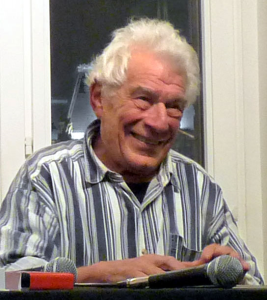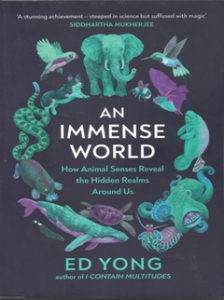Senses, Sensory Bubbles, and the Art of Enlightenment

Ajith Balakrishna
1989 EE
The ways we see the world
I focus my eyes on an object in a scene, much like a camera lens. The act involves ignoring other objects by pushing them into the peripheral vision or background. Now I see that object in a certain way. Then, as I move with my gaze fixed on the object, I start to see it from a different angle and perspective.
Why did I choose that point of view? What habits, presumptions, and preferences did I have when I saw what I saw? These questions are not just about how we see things. They may also be asked about works of art, photographs, videos, or any other form of visual imagery that represents what we see in some manner. Why did a photographer or artist create an image in a particular way? Why do we see those images the way we do?
The point is that there isn’t just one way to see; there are many! And the answer to why there are so many ways may not be straightforward.
When art critic John Berger and producer Mike Dibb decided to create a TV series in 1972 to challenge “the assumptions usually made about the tradition of European painting,” they chose the title Ways of Seeing. The series was later adapted into a book with the same title, which became one of the most influential in art criticism. It was revolutionary. It changed people’s perceptions of visual images and how we see the world!
I recall how enthralled I was by the book the first time I read it. It included seven numbered essays, four of which used both words and images and the others only images. Walking through that intriguing ensemble was a fascinating and eye-opening experience. Ways of Seeing showed me what lay behind the multiple ways of looking at things.
According to Berger, how we are taught to see the world shapes how we see it. A Marxist, he believed that much lay beneath the surface of social consciousness. The social consciousness of humans does not determine their existence; rather, their social existence determines their consciousness. In other words, the entire superstructure of human beliefs in each era, whether moral, philosophical, or religious, can be viewed as echoing the daily business of life at the time.
Berger’s critique of how we see the world was based on this material understanding of history and society. We make many assumptions about the nature of beauty, truth, taste, form, and other concepts that shape our perspective. Our social identities, such as class and gender, always inform these assumptions. For Berger, realism in any form of visual art is always a socially constructed presentation.
You see this in the ‘male gaze’, a term he coined while analyzing how men and women are represented in art and society. It is a theory that feminist theorists such as Laura Mulvey later expanded into a comprehensive critique of how depictions of women in art objectify women in a patriarchal society. According to Berger, while men look at women, women observe themselves being looked at. “Thus she turns herself into an object — and most particularly an object of vision: a sight”.
Though the vision dominates
My recent tryst with Berger’s book happened entirely by chance. I was looking through the bookshelf for another book. Then I saw it and took it out for a quick reread. It was an old secondhand copy of the mass-market paperback edition that I had purchased many years before. The pages had turned yellow and brittle. And it smelled exactly like an old book. But as I reread it, I felt the content was still fresh.
That was interesting. It was simply a book intended to be read. Even then, I was touching and smelling it, attempting to incorporate those sensations into an experience. However, Berger, like most of us, believes that sight is the most valuable sense. ‘Ways of Seeing’ began with the statement, “It is seeing which establishes our place in the surrounding world.”
This is not a surprising assertion. We are a species that prioritizes sight over other senses. The hearing comes in second. Other senses like touch, smell, and taste are confined to the backstage area. In art, we rarely use touch, smell, or taste. We don’t use them a lot in the process of gathering formal knowledge either.
In other words, we must accept that our natural bias toward vision may be ‘coloring’ our perception of the world around us. Furthermore, we are only capable of seeing a limited range of wavelengths of light – from about 400 nanometers (violet) to 700 nanometers (red). Human eyes identify colors with the help of three special types of cells called “cones” in the retina. Each cone type is sensitive to long, medium, and short wavelengths of visible light, which correspond to the colors red, green, and blue. Depending on the wavelengths of the light from an object, these cones are simulated to varying degrees, and the brain identifies the color(s) as a combination of red, green, and blue. it is an efficient mechanism that allows humans to see millions of colors within the visible range.
This, however, implies that the colors we see are constrained by the scheme. Another scheme, with a different spectrum of visible wavelengths or different numbers and types of cones, would show the world in different colors. And that is what happens to other species.
Similar constraints apply to other senses as well. The evolutionary history of each species determines how the senses evolved. On that journey, depending on the complex survival needs, certain senses became dominant while others were neglected. Ultimately, this transition determined what a living being could sense or not.
Umwelt, the sensory bubble
We frequently limit our senses to the five most prominent human senses: sight, hearing, taste, smell, and touch. In the Western world, it was Aristotle who first classified the senses into five categories in his famous treatise De Anima (On the Soul). Five jnanendriyas (senses of perception) are also mentioned in Eastern philosophies, sometimes in conjunction with a sixth sense, the mind. However, some scientists believe that humans have more senses than that. Not-so-obvious senses include the sense of heat (Thermoception), the sense of balance (Equilibrioception), and the sense of pain (Nociception).
The classification of senses in other species is even more difficult. The numerous ways living beings evolved to sense the world through smells, tastes, lights, sounds, heat, chemicals, surface vibrations, contact, electric and magnetic fields, and so on are mind-boggling.
“An Immense World: How Animal Senses Reveal the Hidden Realms Around Us,” the latest book by Ed Yong, a science journalist for The Atlantic, is a gateway to this amazingly sensuous world. This fascinating book, written in an engaging and accessible style, explores the various ways that animals perceive their surroundings. Yong expertly combines scientific research, personal anecdotes, and vivid descriptions of animal behavior. He guides us through the animal kingdom, showing how animals use their senses to find food, navigate, communicate, and reproduce.
From the microscopic world of insects to creatures swimming in vast oceans, each species lives in its sensory bubble that other species may not understand. Dogs have an acute sense of smell, which they use to find their way around. They have more olfactory receptors, each containing multiple times more neurons than we humans. We can never fathom what a dog smells when it sniffs. Butterflies have ears on their wings that help them to detect approaching predators. The orb web serves as an extension of the Nephilia spider’s sensory system. Dolphins use sonic images to distinguish prey like fish from other objects and to navigate underwater. Snakes use their forked tongues to smell, while elephants use their trunks. A mantis shrimp’s three-part eyes allow it to perceive colors in ways that no other animal can.
The point is that every animal doesn’t sense all the stimuli nature offers. And whatever they sense they do it in their own ways. Each lives in its sensory bubble. Yong employs the German term ‘Umwelt’ to describe it. It was a term coined by Baltic German biologist Jakob von Uexküll in the early 20th century to denote an animal’s perceptual surroundings that it can sense and experience.
Umwelten that each animal inhabits serves as a reminder for us of the absurdity of adopting an anthropomorphic attitude while studying other living beings. We are neither unique nor central in the animal world. There is no way we can say that we adorn a special place in the tree of evolution. For all we know, a microbe might be able to survive while we fail when circumstances change.
Philosophers’ dilemma
How we understand the world around us has always been a contentious topic in philosophy. According to René Descartes, the father of modern philosophy, the senses were basically untrustworthy. Our senses can occasionally deceive us. So, too, can our memories and our very existence. Then, what can one do to find certainty? Doubt everything. The only thing that you can’t doubt is the fact that you are thinking. The very act of doubting proves that you are thinking. You must therefore exist. Cogito, ergo sum (I think, therefore I am).
It must be noted that, while the philosophy of Descartes sounds abstract, his contributions to mathematics like analytic geometry or Cartesian geometry had far-reaching pragmatic influences on modern science and technology development. These contributions can’t be separated from his worldview.
Descartes’s rationalism found formidable opposition in the works of empiricists. This philosophical tradition, which became a major influence in Western philosophy in the 17th century, contended that all knowledge was derived from sensory experience. John Locke argued that all of our ideas come from experience through sensation or reflection.
David Hume, a brilliant mind who turned to philosophy at a young age and nearly had a mental breakdown in that pursuit, went one step further. He noted that we can never know anything with certainty because all knowledge is based on our senses, and our senses can be deceived. It might appear that our thoughts have unbounded liberty, Hume wrote in An Enquiry Concerning Human Understanding. But a closer examination reveals another story. Its creative power is confined to manipulating the inputs from the senses and experiences.
The schism between Hume’s empiricism and rationalism embedded in Descartes’ philosophy and Newtonian science bothered Immanuel Kant, one of the greatest thinkers of the Enlightenment, in the 18th century. He wished to reconcile them. On the one hand, he believed in mathematical reasoning and rationalism. At the same time, he recognized the significance of Hume’s attack on causality. Hume “interrupted my dogmatic slumber”, he wrote.
In his seminal work in modern philosophy, The Critique of Pure Reason, published in 1781, Kant argued that we cannot make sense of the world solely through our senses; another faculty, understanding, is required to complete the process. This led him to propose a priori concepts such as space, time, and causality, which are independent of sensual experiences.
Modern mind’s predicament
These debates have never been settled. Richard Tarnas, author of ‘The Passion of the Western Mind,’ a magnificent book on Western philosophy, identified three fundamental shifts that shaped the modern mind. He symbolically linked these shifts to the contributions of Copernicus, Descartes, and Kant to philosophy and science.
The Copernican revolution dethroned the Earth as the center of the universe, replacing it with the Sun and reducing man to insignificance in the grand scheme of things. That process continues through theories of evolution and a constantly growing understanding of the cosmos.
Descartes emphasized the schism between the conscious human subject and the unconscious world. Scientific developments to date have only ratified and augmented this divide. Modern science has revealed a world devoid of spiritual meaning. It has no innate meaning.
The third shift was Kant’s “recognition of the human mind’s subjective ordering of reality”. This was the turning point in the modern-to-postmodern transition. Later developments in science and philosophy broadened this shift, from Marx, Nietzsche, Weber, and Freud to Heisenberg, Wittgenstein, Kuhn, and Foucault. Tarnas describes this change: “The world is in some essential sense a construct. Human knowledge is radically interpretive. There are no perspective-independent facts. Every act of perception and cognition is contingent, mediated, situated, contextual, theory-soaked. Human language cannot establish its ground in an independent reality.”
The conclusions are clear: Anthropocentrism is a distant dream. At the same time, even though many philosophers have tried hard to place God in their interpretation of the world, we have not been able to find a God with certainty. The universe continues to be devoid of any inherent spiritual meaning. The world as we know it is fundamentally a construct, and all knowledge is biased in some way.
One will be tempted to propose that the lack of special privileges in this world and uncertainty about knowledge make modern humans more modest in their endeavors. But an astute observer may disagree. She will say that what she sees everywhere is the race to control nature at any cost, driven by the desire for limitless growth and profit and it is not a humble venture. Its effects are visible all around: growing inequities and inequalities; scarcity of essential resources like water; the environmental emergency in the form of global warming and climate change that has started assuming an existential threat to life itself; and so on.
Humble enlightenment or self-destructive and delusional grandiosity? There is a need to reconcile the essentially fragmented nature of our understanding of the world and the misleading grand narratives of the ‘progress’ that this same knowledge spurs.
At this point, our astute observer may become cynical and claim that the answer to this existential question also is simply a matter of perspective. Coming to think of it, this is not an unacceptable proposition, because it puts the onus of choosing in our hands. Art of enlightenment in our sensory bubble!
















